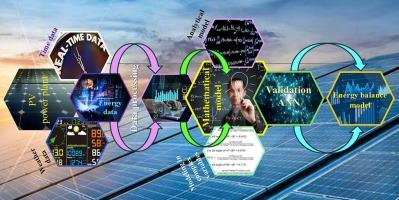多维PV倾角优化的混合神经网络-传递函数框架
IF 7.6
Q1 ENERGY & FUELS
引用次数: 0
摘要
本文重点研究优化技术和决策过程在光伏能源系统中的应用,并辅以旨在解决能源相关建模问题的数据分析方法。本研究应用了一个集成的框架来分析、建模和评估光伏系统的能量平衡,将传递函数方法与神经网络与蒙特卡罗模拟相结合,以优化面板倾斜、电网交互、自我消耗和经济回报。本文提出了确定光伏系统最佳倾角的数学模型和多步计算算法,倾角范围为0°~ 90°。该模型描述了系统的能量平衡,并使其能够在不同条件下进行分析识别。开发了一种使用拉普拉斯变换的扩展建模算法来验证分析模型,并通过应用人工神经网络进行进一步验证。在倾斜角度为25°的情况下,进行了复杂的模拟过程,包括统计评估分析模型的参数与在复杂变量域中定义的模型参数之间的关系,跨越不同的时间段。对关键量化指标观察到的差异进行统计学意义评价。结果证实了原模型的高效度,为93.9%,证明了所提出的建模程序和复变量验证方法的实用性。此外,该框架整合了经济评估,显示25°左右的倾斜角度可提供最高的能源产量(5230千瓦时/年)和最佳净现值(14,707欧元),而垂直面板可减少高达16.2%的能源产量。因此,拟议的框架为中欧气候条件下优化光伏系统设计提供了严格的技术基础和经济依据。本文章由计算机程序翻译,如有差异,请以英文原文为准。

A hybrid ANN-transfer function framework for multi-dimensional PV tilt angle optimization
The manuscript focuses on the application of optimization techniques and decision-making processes in photovoltaic energy systems, supported by data analysis methods aimed at solving energy-related modelling problems. This study applies an integrated framework for the analysis, modelling, and evaluation of a photovoltaic system’s energy balance, combining transfer-function methods with neural networks with Monte Carlo simulation to optimise panel tilt, grid interaction, self-consumption, and economic payback. The work presents a mathematical model and a multi-step calculation algorithm for determining the optimum tilt angle of a photovoltaic system, with the tilt angle ranging from 0° to 90°. The model describes the system’s energy balance and enables its analytical identification under varying conditions. An extended modelling algorithm using Laplace transform was developed to validate the analytical model, with further verification carried out through the application of an artificial neural network. A complex simulation procedure was carried out for a tilt angle of 25°, including statistical evaluation of the relationship between the parameters of the analytical model and those of the model defined in a complex variable domain, across different time periods. Statistical significance of the observed differences in key quantification indices was assessed. The results confirmed a high level of validity 93.9% of the original model and demonstrated the practical applicability of the proposed modelling procedure and verification method using complex variable. Furthermore, the framework integrates economic assessment, revealed that tilt angles around 25° provide the highest energy yield (5230 kWh/year) and best net present value (€14,707), whereas vertical panels reduce energy yield by up to 16.2%. The proposed framework therefore provides a rigorous technical basis and economic justification for optimised PV system design under Central European climatic conditions.
求助全文
通过发布文献求助,成功后即可免费获取论文全文。
去求助
来源期刊

Energy Conversion and Management-X
Multiple-
CiteScore
8.80
自引率
3.20%
发文量
180
审稿时长
58 days
期刊介绍:
Energy Conversion and Management: X is the open access extension of the reputable journal Energy Conversion and Management, serving as a platform for interdisciplinary research on a wide array of critical energy subjects. The journal is dedicated to publishing original contributions and in-depth technical review articles that present groundbreaking research on topics spanning energy generation, utilization, conversion, storage, transmission, conservation, management, and sustainability.
The scope of Energy Conversion and Management: X encompasses various forms of energy, including mechanical, thermal, nuclear, chemical, electromagnetic, magnetic, and electric energy. It addresses all known energy resources, highlighting both conventional sources like fossil fuels and nuclear power, as well as renewable resources such as solar, biomass, hydro, wind, geothermal, and ocean energy.
 求助内容:
求助内容: 应助结果提醒方式:
应助结果提醒方式:


